October 30, 1894 – “Golden Rule” Jones invents a Better Sucker Rod –
Samuel M. Jones patented a sucker rod design for his Acme Sucker Rod Company, which he had founded in 1892 in Toledo, Ohio. With his “Coupling for Pipes or Rods,” Jones applied his oilfield experience in mechanics to solve the frequent and time-consuming problem of broken sucker rods. His innovation would soon make him a millionaire.
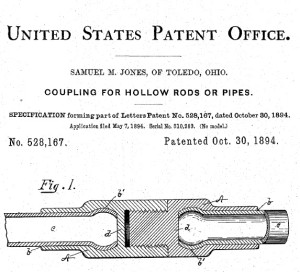
Samuel Jones had worked as a potboiler, pumper, tool dresser, blacksmith, and pipe layer.
Jones had worked in Pennsylvania’s oil region as a potboiler, pumper, tool dresser, blacksmith, and pipe layer. He became known as “Golden Rule” Jones by establishing a better workplace for employees at his factory, where he shortened the work day and started a revenue-sharing program.
Jones ran for Toledo mayor as a progressive Republican in 1887 and was elected. He was reelected three times and served until dying on the job in 1904.
Learn more in “Golden Rule” Jones of Ohio.
October 31, 1871 – Modern Refinery Method patented
Petroleum refining would become more efficient thanks to an invention by Henry Rogers of Brooklyn, New York, who patented an “apparatus for separating volatile hydrocarbons by repeated vaporization and condensation.”
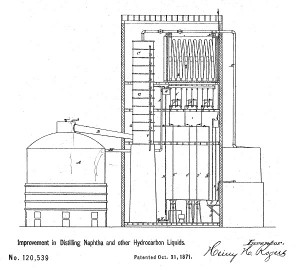
Henry Rogers improved the refining of kerosene.
Rogers introduced many elements of modern refineries, including “fractionating” towers that improved earlier processes of extracting kerosene by simple distillation in kettle stills.
“The apparatus which I use is, in many respects, similar to what is known as the column-still for distilling alcoholic spirits, but modified in all the details, so as to make it available for distilling oils,” Rogers noted in his 1871 patent application. More technological advancements would lead to giant refining operations like the Standard Oil of Indiana Whiting Refinery, which opened in 1889.
October 31, 1903 – Salt-Dome Oilfield discovered in Texas
One mile north of Batson, Texas, a discovery well drilled by W.L. Douglas’ Paraffine Oil Company produced 600 barrels of oil a day from a depth of 790 feet. A second well drilled two months later in the Batson field produced 4,000 barrels of oil a day from 1,000 feet deep. Many new ventures joined the drilling boom (see Buffalo Oil Company).
When combined with other newly discovered prolific salt-dome fields, Spindletop (1901), Sour Lake (1901), and at Humble (1905), “Batson helped to establish the basis of the Texas oil industry when these shallow fields gave up the first Texas Gulf Coast oil,” noted the Texas State Historical Association in 2010.
October 31, 1913 – First Paved U.S. Highway dedicated
Towns and cities nationwide celebrated the opening of the Lincoln Highway, the 3,389-mile-long “Main Street Across America” connecting Times Square in New York City to San Francisco’s Lincoln Park. The Lincoln Highway was the first national memorial dedicated to President Abraham Lincoln. In 1919, the Army Motor Transport Corps organized a transcontinental convoy to test vehicles and highlight the need for more paved roads.
October 31, 1924 – Former Olinda Oil Wells Pitcher plays Exhibition Game
Former oilfield worker Walter “Big Train” Johnson returned to his California oil patch roots for an exhibition game with Babe Ruth in Brea, California. Ruth swatted two home runs off the future Hall of Fame pitcher. Three decades earlier, Johnson had started his baseball career as a 16-year-old pitcher for the Olinda Oil Wells.
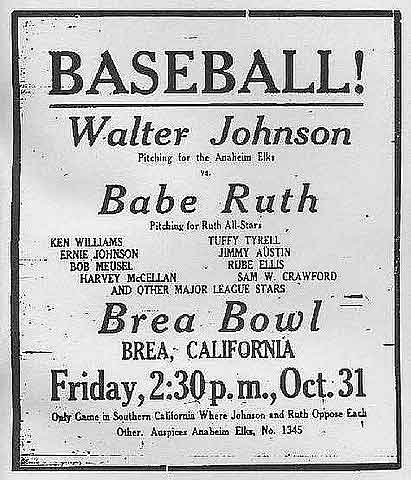
The former star player for the Olinda Oil Wells pitched against Babe Ruth in a 1924 exhibition game in nearby Brea.
Playing for the Washington Senators, the former roustabout became major league baseball’s all-time career leader in shutouts with 110. Many oilfield towns once fielded teams with names proudly reflecting their communities’ livelihood.
Learn more in Oilfields of Dreams – Gassers, Oilers, and Drillers Baseball Teams.
October 31, 1930 – Properties of Columbus “Dad” Joiner placed into Receivership
After it was learned 70-year-old wildcatter Columbus Marion “Dad” Joiner had oversold his East Texas oilfield leases in Rusk County, District Judge R.T. Brown placed the properties into receivership.
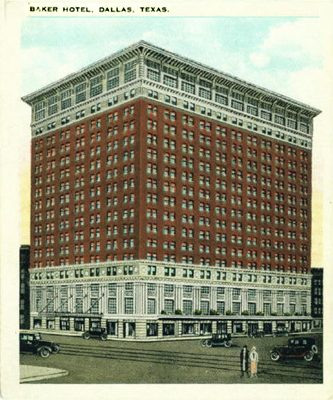
The Baker Hotel in Dallas was where Columbus “Dad” Joiner, discoverer of the East Texas oilfield, met with H.L. Hunt and sold Hunt 5,580 acres for $1.34 million. Built in 1925, the hotel was torn down in 1980.
With the field’s Daisy Bradford No. 3 and other wells tied up in conflicting claims, Joiner took refuge from creditors in the Baker Hotel in Dallas, where Haroldson Lafayette (H.L.) Hunt negotiated a $1.34 million deal with him for the discovery well and 5,580 acres of leases. In the 300 lawsuits and 10 years of litigation that followed, Hunt sustained every title.
November 1, 1865 – First Railroad Oil Tank Car arrives
The first of James and Amos Densmore’s innovative railroad oil tank cars arrived at the Miller Farm, four miles south of Titusville, Pennsylvania. The inventors would be awarded a U.S. patent on April 10, 1866, for their dual tank design.

Brothers Amos and James Densmore designed and built the first successful railroad tank cars used in the Pennsylvania oilfields in 1865. Photo courtesy Drake Well Museum.
The crude oil for the iron-banded wooden tanks on a flatcar was delivered by Samuel Van Syckle’s two-inch iron pipeline (another oil industry first) from the oilfield boom town at Pithole Creek. Oil from large storage tanks on the farm filled the Densmore tanks for the Oil Creek Railroad, which connected to lines reaching Pittsburgh, New York City, and other markets.
Learn more in Densmore Brothers Oil Tank Car.
November 2, 1902 – First Gas-Powered Locomobile delivered
Known for building luxury steam-powered automobiles, the Locomobile Company of America delivered its first gasoline-powered auto to a buyer in New York City. The company had hired Andrew Riker, a self-taught engineer and racecar driver, to create the four-cylinder, 12-horsepower vehicle, which sold for $4,000.

The four-cylinder gasoline engine of Locomobile “Old 16” racing car on display in the Henry Ford Museum, Dearborn, Michigan.
In 1908, a Locomobile “Old 16,” a four-cylinder, 16-liter, two-seater, won America’s first international racing victory — the Vanderbilt Cup at the Long Island Motor Parkway, one of the first paved parkways. The Locomobile Company would “reign supreme in the niche category of luxury American cars for decades,” according to Today in Connecticut History.
November 3, 1878 – Haymaker Natural Gas Well lights Pittsburgh
While drilling for oil in 1878, a well drilled by Michael and Obediah Haymaker erupted with natural gas from a depth of almost 1,400 feet. “Every piece of rigging went sky high, whirling around like so much paper caught in a gust of wind. But instead of oil, we had struck gas,” Michael Haymaker recalled.
Eighteen miles east of Pittsburgh, the out-of-control well in Murrysville, Pennsylvania, produced an estimated 34 million cubic feet of natural gas daily. It was considered the largest natural gas well ever drilled up to that time.
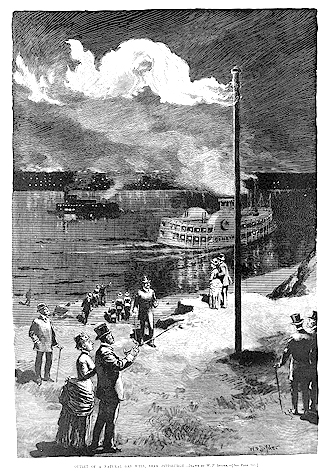
“A sight that can be seen in no other city in the world,” noted Harper’s Weekly in 1885.
Given oilfield technologies of the late 1880s, there was no way to cap the well and no pipeline to exploit commercial possibilities. The Haymaker well drew thousands of curious onlookers to a flaming torch that burned for 18 months and was visible miles away.
“Outlet of a natural gas well near Pittsburgh — a sight that can be seen in no other city in the world,” noted Harper’s Weekly. When finally brought under control, the Haymaker well provided inexpensive gas light to Pittsburgh for many years.
Learn more in Natural Gas is King in Pittsburgh.
November 3, 1900 – New York City hosts First U.S. Auto Show
America’s first gathering of the latest automotive technologies attracted thousands to New York City’s Madison Square Garden. Manufacturers presented 160 different vehicles and conducted driving and maneuverability demonstrations on a 20-foot-wide wooden track that encircled the exhibits.
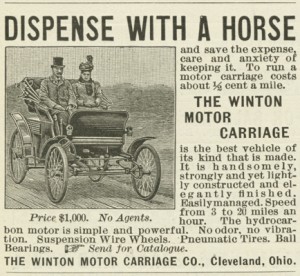
The Winton Motor Carriage of 1898 was the first American automobile advertisement.
Almost 50,000 visitors paid 50 cents each to witness autos driving up a 200-foot ramp to test hill-climbing power. The most popular models proved to be electric, steam, and gasoline…in that order. New Yorkers welcomed the new models as a way to reduce the 450,000 tons of manure and 15,000 horse carcasses that had to be removed from city streets every year.
Of the 4,200 automobiles sold in 1900, less than a thousand were powered by gasoline. But within five years, consumer preference established the dominance of gasoline-powered autos.
Learn more in Cantankerous Combustion — 1st U.S. Auto Show and First Gas Pump and Service Station.
_______________________
Recommended Reading: Holy Toledo: Religion and Politics in the Life of “Golden Rule” Jones (1998); The Bradford Oil Refinery, Pennsylvania, Images of America
(2006); Early Texas Oil: A Photographic History, 1866-1936
(2000); The Lincoln Highway: Coast to Coast from Times Square to the Golden Gate
(2011); Oil on the Brain: Petroleum’s Long, Strange Trip to Your Tank
(2008); The Extraction State, A History of Natural Gas in America(2021); A History of the New York International Auto Show: 1900-2000
(2000). Your Amazon purchase benefits the American Oil & Gas Historical Society. As an Amazon Associate, AOGHS earns a commission from qualifying purchases.
_______________________
The American Oil & Gas Historical Society (AOGHS) preserves U.S. petroleum history. Become an AOGHS annual supporting member and help maintain this energy education website and expand historical research. For more information, contact bawells@aoghs.org. Copyright © 2023 Bruce A. Wells. All rights reserved.
.


